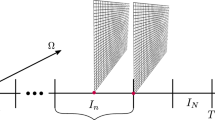Abstract
Solid modelling involves processing large amounts of geometric data. Distributed processing is a promising technique for improving the speed of computationally intensive processes. Solid modelling is thus a good candidate for parallel processing. We present a method for distributing entities of solid models in an array of processors for intersection tests in evaluating boolean operations. We employ distributed boundary representation and a recursive spatial subdivision technique for data partitioning. Parallel algorithms distribute entities among the array of processors mapped to a set of 3D rectangular regions in the object space. Entities intersecting or residing in the intersection regions of the objects are distributed. An experimental system was implemented on a DECmpp 12000/Sx/8K distributed memory SIMD computer.
Similar content being viewed by others
References
Akman V, Franklin WR, Kankanhalli M, Narayanaswami C (1989) Geometric computing and the uniform grid data structure. Comput Aided Design 21:410–420
Bajaj CL, Dey TK (1994) Constructive solid geometry on a MIMD distributed memory machine. Proceedings of CSG94 Set-theoretic Solid Modelling: Techniques and Applications, pp 213–223
Ellis J, Kedem G, Marisa R, Menon J, Voelcker H (1991) Breaking barriers in solid modelling. ASME Mech Eng 113:28–34
Franklin WR (1980) A linear time exact hidden surface algorithm. ACM Comput Graph 14:117–123
Franklin WR (1982) Efficient polyhedron intersection and union. Proceedings of Graphics Interface'82, Toronto, pp 73–80
Franklin WR (1987) Polygon properties calculated from the vertex neighborhoods. Proceedings of the 3rd Annual Symposium on Computational Geometry, Waterloo, Canada, pp 110–118
Franklin WR, Chandrashekar N, Kankanhalli M, Seahan M, Akman V (1988) Efficiency of uniform grids for intersection detection on serial and parallel machines. Proceedings of CG International '88, New Trends in Computer Graphics, pp 288–297
Gursoz EL, Choi Y, Prinz FB (1991) Boolean set operations on non-manifold boundary representation objects. Comput Aided Design 23:33–39
Holliman NS, Wang CM, Dew PM (1993) Mistral-3: parallel solid modelling. Visual Comput 9:356–370
Karasick M (1988) On the representation and manipulation of rigid solids. PhD dissertation, McGill University, Montreal
Masuda H, Shimada K, Numao M, Kawabe S (1990) A mathematical theory and applications of non-manifold geometric modeling. In: Krause F, Jansen H (eds) Advanced Geometric Modelling for Engineering Applications, Elsevier Science, IFIP/GI, North-Holland, Amsterdam New York Oxford Tokyo, pp 89–103
Narayanaswami C (1990) Parallel processing for geometric applications. PhD dissertation, Rensselaer Polytechnic Institute, Tory, NY
Narayanaswami C, Franklin WR (1991) Determination of mass properties of polygonal CSG objects in parallel. Int J Comput Geom Appl 1:381–403
Strip D, Karasick M (1992) Solid modeling on a massively parallel processor. Int J Supercomput Appl 6:175–192
Weiler K (1985) Edge-based data structures for solid modeling in curved-surface environments. IEEE Comput Graph Appl 5:21–40
Whitman S, Hansen CD, Crockett TW (1994) Recent developments in parallel rendering. IEEE Comput Graph Appl 14:21–22
Yamaguchi F, Tokieda T (1985) A solid modeler with a 4×4 determinant processor. IEEE Comput Graph Appl 5:51–59
Author information
Authors and Affiliations
Corresponding author
Rights and permissions
About this article
Cite this article
Hui, K.C., Kan, Y.M. Data partitioning for parallel solid modelling. The Visual Computer 11, 526–541 (1995). https://doi.org/10.1007/BF02434039
Issue Date:
DOI: https://doi.org/10.1007/BF02434039




